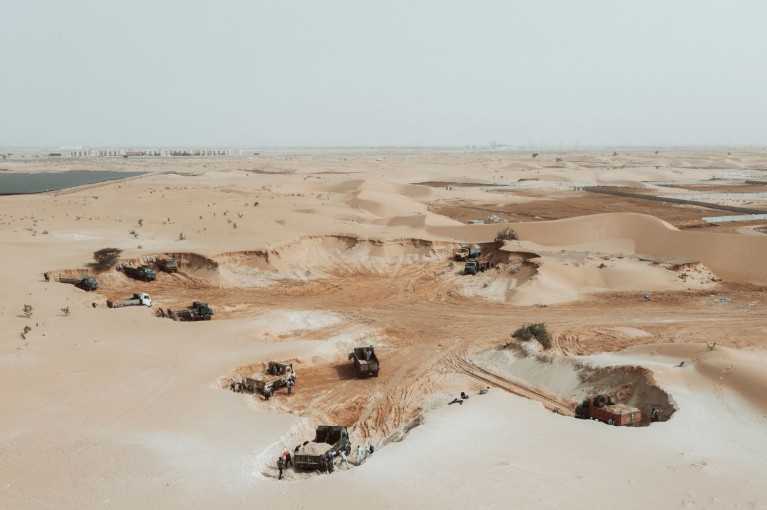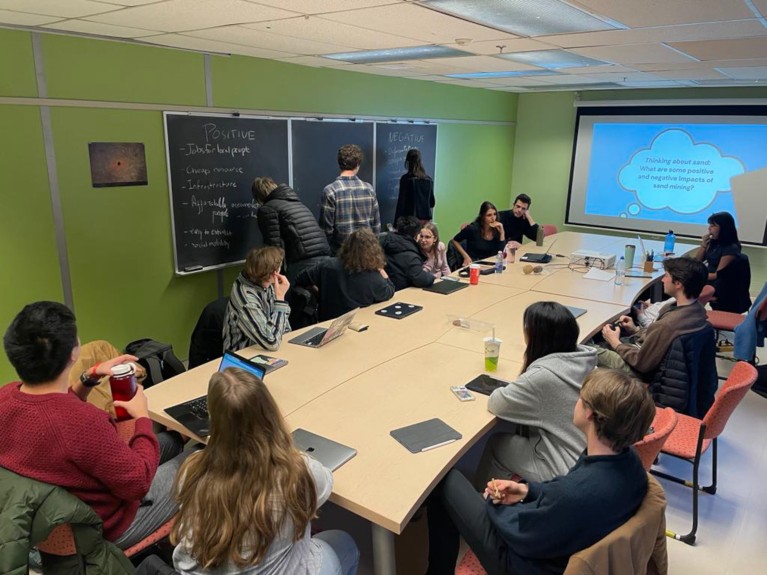
Sand is the most extracted commodity in the world.Credit: Marco Longari/AFP via Getty
We started our faculty positions in Canada after spending two years as postdocs in the United States. At the time, the COVID-19 pandemic was winding down and in-person activities were slowly returning to normal.
In this phase of our careers at McGill University in Montreal (where M.B., a geographer, started working in 2021, followed a year later by her husband, L.I., a biologist), we noticed that students seemed hesitant to engage during classes and were often reluctant to approach us.
This felt like a stark contrast to our PhD studies in Denmark, in which students and faculty members interacted more casually, calling professors by their first name or simply knocking on their door to ask questions.
We noticed a similar reticence from students seeking to join our laboratories as research assistants. We wondered whether, after years of studying in isolation (some of them, like us, new to the country), the students were reluctant to engage informally with both peers and instructors.
To attract their interest and inject some informality, in March 2022, we launched SandClub; an interdisciplinary journal club focused on global sand scarcity.
Sand is the world’s most extracted commodity and most-used natural resource after water. Together with gravel and crushed stone, it is a key ingredient in modern societies, because it goes into concrete and glass. Yet, its extraction remains mostly unregulated and is still an understudied topic.
We felt that a journal club would be a great place to start raising awareness of the important issue, and provide a casual, welcoming community for students from all backgrounds and disciplines.
We wondered whether the name was too provocative, because it builds off the 1999 cult movie Fight Club, in which a disillusioned main character establishes a hidden and exclusive brotherhood through a fight club. But with a witty spin, our point was the exact opposite: ‘First rule of SandClub: you talk about SandClub’.
At first, we followed a classic journal-club format — reading and discussing relevant and recently published articles. We quickly realized that students wanted more than just paper critiques, but we were careful not to add more extracurricular work to their plates. We surveyed the club and were surprised to learn that many indeed wanted presentations and opportunities to undertake research themselves.
As a result, we expanded the focus to include broader sedimentary processes and impacts of climate change, and pivoted SandClub towards more-participatory activities. Participants have described how they now feel more confident speaking up in class settings, and that it has given them a better understanding of what often seems like a ‘black box of research’; they’ve developed critical-thinking skills and learnt to analyse data and review manuscripts. Some 3 years in, we have run 25 journal-club sessions, involving more than 60 students from 5 faculties, coming from more than 30 majors. SandClub typically is held twice a month during the semester with about 10–15 attendees, and we bring plenty of snacks. At first, the afternoon meetings conflicted with our young son’s schedule, so we just brought him along. At times, he participated in the discussion, at others, he finished homework, sometimes helped by one or more of the students. Their interactions helped to create a relaxed atmosphere, and reinforced the idea that academia does not have to be rigid — it can be a community in which all are welcome.
We heard that students appreciate the open atmosphere for conversation and learning. One described that the “almost horizontal relationship” between students and professors as “something they had not experienced elsewhere at the university during their studies”. This informal and non-hierarchical relationship helps us to foster a the kind of atmosphere and learning environment in which students flourish.
We expanded the format and activities in response to student feedback and the growing interest, offering activities that could be included in their CVs. For example, when asked to review papers, we now ask editors whether we can share the manuscript with SandClub members, enabling students to formally participate in the reviewing process. We incorporate some of their comments in our reviews, including for papers in Nature Geoscience and Nature Sustainability. We update the students on manuscript decisions and hope that, by demystifying the peer-review and publishing process, the students are exposed to this often hidden aspect of research, helping them to understand how research moves from draft to publication.

A SandClub session, at McGill University in Montreal, Canada.Credit: Mette Bendixen
We have been impressed by their ability to think critically about complex topics around sand scarcity. With student backgrounds spanning geography, biology and the environment, anthropology, engineering and political science, it is helpful for us as reviewers to get perspectives that we might not have thought about. And students say that it has deepened their respect for this lengthy, often tedious process of research publishing and peer review, and shown them that their voice matters.


